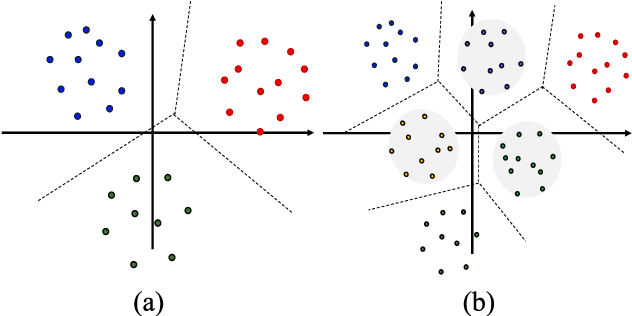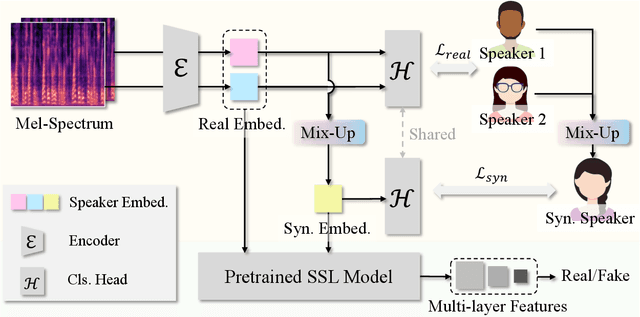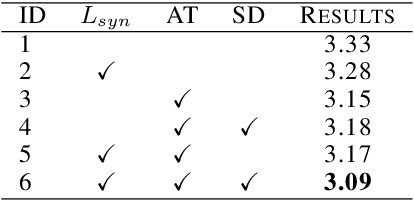Bhiksha Raj
Language Technologies Institute, Carnegie Mellon University, Mohammed bin Zayed University of AI
AURA Score: A Metric For Holistic Audio Question Answering Evaluation
Oct 06, 2025Abstract:Audio Question Answering (AQA) is a key task for evaluating Audio-Language Models (ALMs), yet assessing open-ended responses remains challenging. Existing metrics used for AQA such as BLEU, METEOR and BERTScore, mostly adapted from NLP and audio captioning, rely on surface similarity and fail to account for question context, reasoning, and partial correctness. To address the gap in literature, we make three contributions in this work. First, we introduce AQEval to enable systematic benchmarking of AQA metrics. It is the first benchmark of its kind, consisting of 10k model responses annotated by multiple humans for their correctness and relevance. Second, we conduct a comprehensive analysis of existing AQA metrics on AQEval, highlighting weak correlation with human judgment, especially for longer answers. Third, we propose a new metric - AURA score, to better evaluate open-ended model responses. On AQEval, AURA achieves state-of-the-art correlation with human ratings, significantly outperforming all baselines. Through this work, we aim to highlight the limitations of current AQA evaluation methods and motivate better metrics. We release both the AQEval benchmark and the AURA metric to support future research in holistic AQA evaluation.
Image Tokenizer Needs Post-Training
Sep 15, 2025Abstract:Recent image generative models typically capture the image distribution in a pre-constructed latent space, relying on a frozen image tokenizer. However, there exists a significant discrepancy between the reconstruction and generation distribution, where current tokenizers only prioritize the reconstruction task that happens before generative training without considering the generation errors during sampling. In this paper, we comprehensively analyze the reason for this discrepancy in a discrete latent space, and, from which, we propose a novel tokenizer training scheme including both main-training and post-training, focusing on improving latent space construction and decoding respectively. During the main training, a latent perturbation strategy is proposed to simulate sampling noises, \ie, the unexpected tokens generated in generative inference. Specifically, we propose a plug-and-play tokenizer training scheme, which significantly enhances the robustness of tokenizer, thus boosting the generation quality and convergence speed, and a novel tokenizer evaluation metric, \ie, pFID, which successfully correlates the tokenizer performance to generation quality. During post-training, we further optimize the tokenizer decoder regarding a well-trained generative model to mitigate the distribution difference between generated and reconstructed tokens. With a $\sim$400M generator, a discrete tokenizer trained with our proposed main training achieves a notable 1.60 gFID and further obtains 1.36 gFID with the additional post-training. Further experiments are conducted to broadly validate the effectiveness of our post-training strategy on off-the-shelf discrete and continuous tokenizers, coupled with autoregressive and diffusion-based generators.
Less is More Tokens: Efficient Math Reasoning via Difficulty-Aware Chain-of-Thought Distillation
Sep 05, 2025



Abstract:Chain-of-thought reasoning, while powerful, can produce unnecessarily verbose output for simpler problems. We present a framework for difficulty-aware reasoning that teaches models to dynamically adjust reasoning depth based on problem complexity. Remarkably, we show that models can be endowed with such dynamic inference pathways without any architectural modifications; we simply post-train on data that is carefully curated to include chain-of-thought traces that are proportional in length to problem difficulty. Our analysis reveals that post-training via supervised fine-tuning (SFT) primarily captures patterns like reasoning length and format, while direct preference optimization (DPO) preserves reasoning accuracy, with their combination reducing length and maintaining or improving performance. Both quantitative metrics and qualitative assessments confirm that models can learn to "think proportionally", reasoning minimally on simple problems while maintaining depth for complex ones.
OleSpeech-IV: A Large-Scale Multispeaker and Multilingual Conversational Speech Dataset with Diverse Topics
Sep 04, 2025Abstract:OleSpeech-IV dataset is a large-scale multispeaker and multilingual conversational speech dataset with diverse topics. The audio content comes from publicly-available English podcasts, talk shows, teleconferences, and other conversations. Speaker names, turns, and transcripts are human-sourced and refined by a proprietary pipeline, while additional information such as timestamps and confidence scores is derived from the pipeline. The IV denotes its position as Tier IV in the Olewave dataset series. In addition, we have open-sourced a subset, OleSpeech-IV-2025-EN-AR-100, for non-commercial research use.
Directed-Tokens: A Robust Multi-Modality Alignment Approach to Large Language-Vision Models
Aug 19, 2025Abstract:Large multimodal models (LMMs) have gained impressive performance due to their outstanding capability in various understanding tasks. However, these models still suffer from some fundamental limitations related to robustness and generalization due to the alignment and correlation between visual and textual features. In this paper, we introduce a simple but efficient learning mechanism for improving the robust alignment between visual and textual modalities by solving shuffling problems. In particular, the proposed approach can improve reasoning capability, visual understanding, and cross-modality alignment by introducing two new tasks: reconstructing the image order and the text order into the LMM's pre-training and fine-tuning phases. In addition, we propose a new directed-token approach to capture visual and textual knowledge, enabling the capability to reconstruct the correct order of visual inputs. Then, we introduce a new Image-to-Response Guided loss to further improve the visual understanding of the LMM in its responses. The proposed approach consistently achieves state-of-the-art (SoTA) performance compared with prior LMMs on academic task-oriented and instruction-following LMM benchmarks.
CarelessWhisper: Turning Whisper into a Causal Streaming Model
Aug 17, 2025Abstract:Automatic Speech Recognition (ASR) has seen remarkable progress, with models like OpenAI Whisper and NVIDIA Canary achieving state-of-the-art (SOTA) performance in offline transcription. However, these models are not designed for streaming (online or real-time) transcription, due to limitations in their architecture and training methodology. We propose a method to turn the transformer encoder-decoder model into a low-latency streaming model that is careless about future context. We present an analysis explaining why it is not straightforward to convert an encoder-decoder transformer to a low-latency streaming model. Our proposed method modifies the existing (non-causal) encoder to a causal encoder by fine-tuning both the encoder and decoder using Low-Rank Adaptation (LoRA) and a weakly aligned dataset. We then propose an updated inference mechanism that utilizes the fine-tune causal encoder and decoder to yield greedy and beam-search decoding, and is shown to be locally optimal. Experiments on low-latency chunk sizes (less than 300 msec) show that our fine-tuned model outperforms existing non-fine-tuned streaming approaches in most cases, while using a lower complexity. Additionally, we observe that our training process yields better alignment, enabling a simple method for extracting word-level timestamps. We release our training and inference code, along with the fine-tuned models, to support further research and development in streaming ASR.
Deciphering GunType Hierarchy through Acoustic Analysis of Gunshot Recordings
Jun 25, 2025Abstract:The escalating rates of gun-related violence and mass shootings represent a significant threat to public safety. Timely and accurate information for law enforcement agencies is crucial in mitigating these incidents. Current commercial gunshot detection systems, while effective, often come with prohibitive costs. This research explores a cost-effective alternative by leveraging acoustic analysis of gunshot recordings, potentially obtainable from ubiquitous devices like cell phones, to not only detect gunshots but also classify the type of firearm used. This paper details a study on deciphering gun type hierarchies using a curated dataset of 3459 recordings. We investigate the fundamental acoustic characteristics of gunshots, including muzzle blasts and shockwaves, which vary based on firearm type, ammunition, and shooting direction. We propose and evaluate machine learning frameworks, including Support Vector Machines (SVMs) as a baseline and a more advanced Convolutional Neural Network (CNN) architecture for joint gunshot detection and gun type classification. Results indicate that our deep learning approach achieves a mean average precision (mAP) of 0.58 on clean labeled data, outperforming the SVM baseline (mAP 0.39). Challenges related to data quality, environmental noise, and the generalization capabilities when using noisy web-sourced data (mAP 0.35) are also discussed. The long-term vision is to develop a highly accurate, real-time system deployable on common recording devices, significantly reducing detection costs and providing critical intelligence to first responders.
CoLMbo: Speaker Language Model for Descriptive Profiling
Jun 11, 2025Abstract:Speaker recognition systems are often limited to classification tasks and struggle to generate detailed speaker characteristics or provide context-rich descriptions. These models primarily extract embeddings for speaker identification but fail to capture demographic attributes such as dialect, gender, and age in a structured manner. This paper introduces CoLMbo, a Speaker Language Model (SLM) that addresses these limitations by integrating a speaker encoder with prompt-based conditioning. This allows for the creation of detailed captions based on speaker embeddings. CoLMbo utilizes user-defined prompts to adapt dynamically to new speaker characteristics and provides customized descriptions, including regional dialect variations and age-related traits. This innovative approach not only enhances traditional speaker profiling but also excels in zero-shot scenarios across diverse datasets, marking a significant advancement in the field of speaker recognition.
Total-Editing: Head Avatar with Editable Appearance, Motion, and Lighting
May 26, 2025Abstract:Face reenactment and portrait relighting are essential tasks in portrait editing, yet they are typically addressed independently, without much synergy. Most face reenactment methods prioritize motion control and multiview consistency, while portrait relighting focuses on adjusting shading effects. To take advantage of both geometric consistency and illumination awareness, we introduce Total-Editing, a unified portrait editing framework that enables precise control over appearance, motion, and lighting. Specifically, we design a neural radiance field decoder with intrinsic decomposition capabilities. This allows seamless integration of lighting information from portrait images or HDR environment maps into synthesized portraits. We also incorporate a moving least squares based deformation field to enhance the spatiotemporal coherence of avatar motion and shading effects. With these innovations, our unified framework significantly improves the quality and realism of portrait editing results. Further, the multi-source nature of Total-Editing supports more flexible applications, such as illumination transfer from one portrait to another, or portrait animation with customized backgrounds.
CAARMA: Class Augmentation with Adversarial Mixup Regularization
Mar 20, 2025



Abstract:Speaker verification is a typical zero-shot learning task, where inference of unseen classes is performed by comparing embeddings of test instances to known examples. The models performing inference must hence naturally generate embeddings that cluster same-class instances compactly, while maintaining separation across classes. In order to learn to do so, they are typically trained on a large number of classes (speakers), often using specialized losses. However real-world speaker datasets often lack the class diversity needed to effectively learn this in a generalizable manner. We introduce CAARMA, a class augmentation framework that addresses this problem by generating synthetic classes through data mixing in the embedding space, expanding the number of training classes. To ensure the authenticity of the synthetic classes we adopt a novel adversarial refinement mechanism that minimizes categorical distinctions between synthetic and real classes. We evaluate CAARMA on multiple speaker verification tasks, as well as other representative zero-shot comparison-based speech analysis tasks and obtain consistent improvements: our framework demonstrates a significant improvement of 8\% over all baseline models. Code for CAARMA will be released.
 Add to Chrome
Add to Chrome Add to Firefox
Add to Firefox Add to Edge
Add to Edge